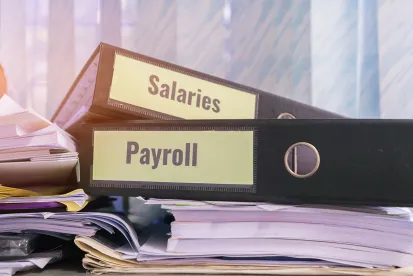[Update: This article has been updated since its initial publication on December 31, 2020.]
On December 27, 2020, President Donald Trump signed into law the Consolidated Appropriations Act, 2021 (the 2021 Consolidated Appropriations Act), an omnibus statute that is comprised of, among other laws, twelve fiscal year 2021 appropriations bills for the federal government and an economic aid package to assist business concerns that continue to face hardships due to the COIVD-19 pandemic. Title III of the 2021 Consolidated Appropriations Act, which is cited as the Economic Aid to Hard-Hit Small Businesses, Nonprofits, and Venues Act (the Act), among other matters, reauthorizes and modifies the Paycheck Protection Program (PPP) and Economic Injury Disaster Loan program (EIDL), as enacted under the Coronavirus Aid, Relief, and Economic Security Act (as amended, supplemented or otherwise modified from time to time prior to the enactment of the Act, including the Paycheck Protection Program and Health Care Enhancement Act, the Paycheck Protection Program Flexibility Act, applicable federal regulations and interpretive guidance issued by the SBA and Treasury (the CARES Act)).
Highlights of the Act, as it pertains to the PPP and the EIDL, are as follows:
I. Revival of the PPP, Funds Committed and Application Deadline
The Act revives the PPP by appropriating $284.45 billion to the program, which is a significant portion of the $325 billion allocated specifically for small business aid in the legislation. As detailed below, the Act reopens applications for businesses seeking PPP funds for the first time (a First Tranche PPP Loan), while expanding the authorized uses for PPP loan proceeds and increasing flexibility to obtain loan forgiveness. The Act also permits eligible business concerns who previously received PPP loans to apply for a second draw of PPP loan proceeds (a Second Tranche PPP Loan), albeit by adopting generally more restrictive eligibility criteria and reducing the maximum amount of proceeds available for a second PPP loan.
The new application deadline to apply for the PPP is March 31, 2021, and the SBA is required to issue regulations to carry out the new provisions of the revitalized program no later than January 6, 2021.
II. Eligibility Criteria for PPP Loan Applicants
Applicants for First Tranche PPP Loans are required to satisfy the eligibility criteria set forth in the CARES Act.[1] PPP borrowers seeking a Second Tranche PPP Loan, however, are subject to a different set of eligibility criteria for the program. Any business concern, nonprofit organization, housing cooperative,[2] veterans organization, tribal business, eligible self-employed individual, sole proprietor, independent contractor or small agricultural cooperative is eligible to receive a Second Tranche PPP Loan if such business (i) employs not more 300 employees and (ii) demonstrates a 25% reduction[3] in gross receipts in the first, second or third quarter in 2020 compared to the same quarter in 2019[4].[5] Importantly, the maximum number of employees size cap of 300 is reduced from the 500-employee cap contained in the CARES Act that continues to apply to First Tranche PPP Loans.[6][7]
Equally noteworthy is the following list of types of business concerns that are expressly prohibited from obtaining a Second Tranche PPP Loan, which list includes some important changes from the list of prohibited applicants for a First Tranche PPP Loan:
-
A business or organization that was not in operation on February 15, 2020;
-
A person or business that is a recipient of the “Shuttered Venue Operators” grant as established by Section 324 of the Act;
-
Business types enumerated in 13 CFR § 120.110 other than (i) non-profit businesses and (ii) businesses principally engaged in teaching, instructing, counseling or indoctrinating religion or religious beliefs, whether in a religious or secular setting;[8]
-
Publicly-traded businesses[9][10];
-
Any business concern or entity primarily engaged in political or lobbying activities, which shall include any entity that is organized for research or for engaging in advocacy in areas such as public policy or political strategy or otherwise describes itself as a think tank in any public documents;
-
501(c)(6) organizations that constitute professional sports leagues and entities with the purpose of promoting or participating in a political campaign or other lobbying activities as defined in Section 3 of the Lobbying Disclosure Act of 1955; and
-
(i) Any business concern of which 20% of its economic interests is owned by an entity (A) created in or organized under the laws of the People’s Republic of China (PRC) or the Special Administrative Region of Hong Kong (Hong Kong) or (B) that has “significant operations”[11] in the PRC or Hong Kong, or (ii) any business concern that has a board member who is a resident of the PRC.[12]
III. Second Tranche PPP Loan for an Existing PPP Borrower; Re-applying for a First Tranche PPP Loan
The Act permits a business that borrowed a First Tranche PPP Loan to apply for and receive a Second Tranche PPP Loan provided (i) the business is able to satisfy the more restrictive Second Tranche PPP Loan eligibility criteria and (ii) the loan proceeds of the First Tranche PPP Loan will have been used in full on or before the expected disbursement date of the Second Tranche PPP Loan.
The Act also calls for the SBA to publish interpretive guidance by January 13, 2021 that permits (i) a PPP applicant that did not accept its First Tranche PPP Loan, or a PPP borrower that returned the full amount of its First Tranche PPP Loan promptly after its disbursement, to re-apply for a First Tranche PPP Loan, and (ii) a PPP borrower that returned less than the full amount of its First Tranche PPP Loan promptly after its disbursement to request an additional funding on its First Tranche PPP Loan in an amount equal to the difference between the loan proceeds the PPP borrower retained and the maximum amount of First Tranche PPP Loan proceeds such PPP borrower is eligible to receive.
IV. Eligibility for PPP Applicants in Bankruptcy
The Act amends Sections 364, 503(b), 1191, 1225, 1325 of the Bankruptcy Code to enable a debtor-in-possession or trustee that is authorized to operate the business of a debtor to apply for and borrow a PPP loan, notwithstanding any contrary contractual restriction, prior prohibition under Section 363 of the Bankruptcy Code regarding use of cash collateral, or other law prohibiting the debtor from incurring additional debt.[13] The Act provides that any PPP loan is to be treated as debt to the extent such loan is not forgiven. The PPP loan will be entitled to priority as an administrative expense, and a plan of reorganization will be confirmable if it proposes that the debtor make payments on the PPP loan when due.
V. Affiliation Rules
Generally, the affiliation rules that applied to applicants of PPP Loans prior to the enactment of the Act continue to apply, except that, for purposes of a Second Tranche PPP Loan, the employee size standard is reduced to a maximum of 300 employees (from 500 employees) for purposes of determining affiliation.[14] For further analysis on the PPP affiliation rules, please visit our firm’s articles here and here.
VI. Covered Period
The Act modifies the forgiveness “covered period,” or the finite period of time in which PPP loan proceeds must be expended on authorized uses in order for such funds to qualify for loan forgiveness, for both First Tranche PPP Loans and Second Tranche PPP Loans to a period that begins on the date of disbursement of the applicable PPP loan and ends on a date selected by the PPP borrower that is not less than 8 weeks but not more than 24 weeks after the date of disbursement. Prior to the enactment of the Act, PPP borrowers were required to elect either an 8-week or 24-week covered period.[15]
VII. Maximum Loan Amount
The maximum amount available for a Second Tranche PPP Loan is the lesser of $2,000,000 and[16]
- For non-seasonal employers, the average total monthly payment for payroll costs for either (as determined by the PPP borrower) (i) the one year period before the date of the loan or (ii) calendar year 2019, multiplied by 2.5.
- For seasonal employers[17], the average total monthly payment for payroll costs incurred or paid by the PPP borrower for any 12-week period between February 15, 2019 and February 15, 2020 as chosen by the PPP borrower, multiplied by 2.5.
- For an employer that is assigned a NAICS code beginning with 72 (the Accommodation and Food Services sector), the average total monthly payment for payroll costs for either (as determined by the PPP borrower) (i) the one year period before the date of the loan, or (ii) calendar year 2019, multiplied by 3.5.[18]
Note that the maximum loan amount of $2 million for a Second Tranche PPP Loan is substantially less than the maximum loan amount of $10 million for a First Tranche PPP Loan.
VIII. Expansion and Modification of Authorized Uses of PPP Loan Proceeds
While authorized uses of PPP loan proceeds continue to include payroll costs, utilities, rent, and interest on mortgages and other debt obligations, the Act permits the proceeds of both First Tranche PPP Loans[19] and Second Tranche PPP Loans to be used for the following additional expense categories (in each case, subject to certain specified exclusions), all of which also qualify for forgiveness:
- Covered Operations Expenditures: payment for any business software or cloud computing services that facilitates business operations, product or service delivery, payroll processing, human resources, sales and billing functions or accounting for supplies, inventory, records and expenses;
- Covered Property Damage Costs: costs related to property damage from vandalism or looting due to public disturbances in 2020, which expenses were not covered by insurance;
- Covered Supplier Costs: supplier costs which are essential to operations or made pursuant to a contract in effect at the time of the PPP loan;
- Covered Worker Protection Expenditures: operating or capital expenditures made to comply with requirements or guidance published by the Department of Health and Human Services, the Centers for Disease Control, Occupational Safety and Health Administration, or any state equivalent from March 1, 2020 until the determination by the President of the end of the national emergency related to COVID-19[20]; and
- Certain Group Insurance Payments:[21] group life, disability, vision and dental insurance benefits.
Further, a business that received a PPP loan prior to the enactment of the Act was not eligible for the employee retention credit as enacted under the CARES Act. The 2021 Appropriations Act revises the existing rules by now permitting PPP borrowers to claim such employee retention tax credit. However, such costs are prohibited from being eligible for forgiveness – specifically, the Act excludes the following from the definition of forgivable “payroll costs”: (i) qualified wages, as defined in Section 2301(c)(3) of the CARES Act taken into account for determining the tax credit under such section, and (ii) qualified wages taken into account in determining the tax credit allowed under Section 303(a) or (d) of the Taxpayer Certainty and Disaster Relief Act of 2020.
As was the case with PPP loans made prior to the enactment of the Act, borrowers must apply at least 60% of the PPP loan proceeds towards “payroll costs” as defined in the CARES Act, and as amended by the Act.
IX. Simplified Forgiveness Application for PPP Loans of $150,000 or Less
The Act simplifies the forgiveness application process for borrowers who have received or will receive PPP loans in the amount of $150,000 or less. For such PPP loans, full forgiveness is available if the borrower signs and submits to its PPP lender a certification in a 1-page form to be finalized by the SBA no later than January 20, 2021. For borrowers who receive PPP loans in an amount greater than $150,000, the required certifications and documentation to be provided for loan forgiveness remain the same as provided under the CARES Act.
X. The SBA’s Audit Procedures
The Act appropriates $50 million directly to the SBA for auditing and fraud mitigation purposes with respect to the PPP. The SBA must submit its audit plan and intended procedures to the Committee on Small Business and Entrepreneurship of the Senate and House by February 10, 2021.
XI. Preservation of Tax Deductibility for Expenses Paid with Proceeds of PPP Loan that is Forgiven
As one of the most significant economic benefits for PPP borrowers, the Act reverses IRS regulations prohibiting, for federal income tax purposes, the deductibility of expenses to which PPP loan proceeds are applied and then forgiven. Similar to the CARES Act, the Act also makes it clear that a PPP borrower will not be subject to federal tax on the basis of the cancellation of indebtedness that results from forgiveness of any portion of a PPP loan.
XII. Additional Funding for the EIDL
The Act appropriates $20 billion in additional funding to the EIDL and extends the application covered period for EIDL grants through December 31, 2021. Small businesses and nonprofits in low income communities that suffered a 30% economic loss[22] and have fewer than 300 employees are eligible to apply for and receive an advance grant of $10,000, or the difference between $10,000 and a previous advance grant amount.
The Act allows the SBA up to 21 days after receiving a request for an EIDL grant to review the borrower’s eligibility and either provide the grant or an explanation why the borrower is ineligible to receive it.
The EIDL grants are not taxable, and under the Act, there is no deduction to any PPP loan forgiveness amount for borrowers who received both an EIDL grant and a PPP Loan. If a borrower’s PPP loan forgiveness amount was previously reduced by the EIDL grant, the Act directs the SBA to issue rules ensuring all borrowers receive equal treatment.[23]
*Things are changing quickly and the measures and interpretations described herein may change. Our analysis is necessarily limited by the time sensitivities of the current crisis, as well as the absence of precedent for some of what is contained here. This analysis represents our best interpretation and recommendations based on where things currently stand.*
FOOTNOTES
[1] For further analysis on the eligibility criteria set forth in the CARES Act for First Tranche PPP Loans, please visit our firm’s articles here, here and here.
[2] “Housing cooperative” and “small agricultural cooperative” were added to the list by the Act.
[3] For applicants seeking PPP loans of not more than $150,000, an eligible business need only certify in its application that such business meets the revenue loss test created under the Act. Adequate documentation evidencing that such business met the revenue loss test must, however, be presented at the time such business submits its forgiveness application for such PPP loans.
[4] The Act considers certain exceptions for eligible businesses who were not in operation for portions of 2019. Also, for applications submitted after January 1, 2021, PPP applicants may compare the revenues of the fourth quarter of 2020 with the revenues of the fourth quarter of 2019.
[5] Section 317 of the Act also makes “news organizations” (defined in the Act to include (i) stations that broadcast pursuant to a Title III FCC license and employ less than 500 employees (or the employee size standard established by such entity’s NAICS Code) per physical location if majority owned or controlled by a business concern with an NAICS Code starting with “511110” (newspaper publishers) or “5151” (broadcasting, except internet) and (ii) public broadcasting entities) eligible for Second Tranche PPP Loans, provided that the business concern makes a good faith certification that the proceeds of the loan will be used to support expenses relating to the “production or distribution of locally focused or emergency information”. Section 318 of the Act further provides certain 501(c)(6) entities and “destination marketing organizations” (as defined in Section 318 of the Act) are eligible to apply for Second Tranche PPP Loans, provided they can satisfy the 300-employee count and loss of revenue tests applicable to other business concerns generally.
[6] Unlike the CARES Act, the Act does not expressly provide that the 300 employee cap is tested only as to employees whose principal place of residence is in the United States.
[7] For Second Tranche PPP Loans, the maximum of 300 employees cap is the only size test expressly stated in the Act to determine general eligibility. The CARES Act and the ensuing implementing SBA regulations and guidance expanded the 500 employee size cap for First Tranche PPP Loans to include, as independent alternative bases of size eligibility, (i) NAICS Code size standards applicable to the primary industry sector in which the PPP loan applicant operates, and (ii) the SBA’s Alternative Size Standards, both of which are used to determine eligibility for other SBA loan programs. For the present, these alternative size tests to determine eligibility remain limited to First Tranche PPP Loans and do not appear to apply to Second Tranche PPP Loans.
[8] While the Act expressly includes non-profits and churches and other religious organizations as being eligible to obtain Second Tranche PPP Loans, the Act makes no mention of the other types of business, including tribal gaming enterprises, that also were, by SBA regulations implementing the CARES Act, expressly carved-out from the list of business concerns ineligible for SBA loans under 13 CFR § 120.110. Unless the SBA acts again through regulation, it would appear that such previously exempted business are excluded from eligibility for Second Tranche PPP Loans.
[9] Section 342 of the Act expressly prohibits publicly-traded businesses from receiving First Tranche PPP Loans after the enactment of the Act.
[10] Publicly traded businesses that are affiliated with news organizations otherwise eligible for the PPP under Section 317 of the Act are, however, eligible to apply for Second Tranche PPP Loans.
[11] The Act does not explain or define the phrase “significant operations,” which may be a critical source of uncertainty for some potential applicants for a Second Tranche PPP Loan.
[12] The Act does not address the treatment of limited liability companies and partnerships that may have managers or general partners, respectively, who are residents of the PRC.
[13] By permitting businesses in bankruptcy proceedings to obtain PPP loans, the Act reverses provisions of the CARES Act (and the decisions of bankruptcy courts) that made debtors and trustees in bankruptcy actions ineligible to obtain PPP loans.
[14] Section 317 of the Act adds an exception to the PPP affiliation rules for news organizations.
[15] It is unclear whether such modification of “covered period” applies to a PPP loan that was made before the enactment of the Act.
[16] Section 312 of the Act considers alternative test periods for eligible businesses that did not exist during the whole of the one-year period from February 15, 2019 to February 15, 2020.
[17] Previously undefined, “seasonal employer” is now defined in Section 315 of the Act as a business that does not operate for more than 7 months in any calendar year or that, during the previous calendar year, had revenues for any 6 months of that year that were not more than 33.33 percent of the revenues of the business for the other 6 months of that year. We note that the definition of “seasonal employer” refers to “any calendar year” and does not expressly exclude calendar year 2020, leaving open the possibility for a PPP borrower that would not be considered a seasonal employer to qualify as a “seasonal employer” if its operations and/or revenues were impacted in calendar year 2020 as a result of COVID-19 or otherwise. It is uncertain as to whether it was Congress’ intention to permit PPP borrowers to consider calendar year 2020 in determining whether such borrower is a “seasonal employer” .
[18] Sections 313 and 314 of the Act set forth alternate maximum PPP loan amount calculations and other loan terms for farmers, ranchers and farm credit system institutions.
[19] Except for any First Tranche PPP Loan that has already been repaid or for which a forgiveness determination has already been made.
[20] Examples of “Covered Worker Protection Expenditures” include purchases for a drive-through window, air filtration or air pressure ventilation units, physical barriers, expansions of outdoor space and personal protective equipment.
[21] This list of benefits has been expressly added to the definition of “payroll costs”.
[22] Section 331 of the Act defines “Economic Loss” as “the amount by which the gross receipts of the covered entity declined during an 8-week period between March 2, 2020, and December 17, 2021, relative to a comparable 8-week period immediately preceding March 2, 2020, or during 2019.” Unfortunately, Section 331 of the Act does not indicate how a particular 8 week period is to be selected for measurement, or by whom.
[23] Section 333 of the Act requires the SBA to issue rules “that ensure the equal treatment of all covered entities… which shall include consideration of covered entities that, before the date of enactment of this Act, completed the loan forgiveness process described in section 1110(e)(6) of the CARES Act (15 U.S.C. 9009(e)(6)) [PPP Loan].”






 />i
/>i

